4 Steps to a Successful Omnichannel Transformation NOW


Today retailers are understanding that the best time to establish omnichannel functionalities is five years ago… the second best time is now. Harnessing all the functionalities of a holistic WMS to seamlessly transform your business to an omnichannel masterpiece will determine your survival in a market that is more competitive than ever before.
Following on from our critical insights for successful e-commerce omnichannel strategies we look at what facilitates your transition to the platform of the future.
The sheer range of variables that customer-care functions must account for - internally and externally - can seem overwhelming. By first establishing some parameters on what good looks like and setting priorities by customer segment, companies can gain clarity on where to direct resources.
1. Define strategy and design principles
Companies must develop a customer-service strategy (or set of principles) that encompasses not only a vision for how to deliver an excellent experience, but also how these interactions should feel for their customers, especially existing consumers that they are redirecting to e-commerce channels for the first time.
These principles help companies design service journeys that strike the right balance of speed, transparency, and interaction within each channel and that achieve a successful interplay of digital and live channels. This approach can ensure that companies apply an omnichannel lens to each service journey, rather than focusing on optimising individual touch-points (such as interactive voice response, chat, voice, and digital).
To begin companies must understand both existing AND potential customers by their digital behaviour, and then offer the right channels that best align with the interests of each segment. No two customers are the same, and it’s how they differ in their behaviour and preferences (especially on digital engagement) that will define how service journeys are designed.
There are four basic personas, and each requires different engagement:
Digital by choice - 35%
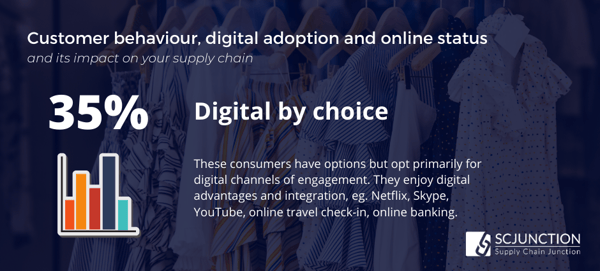
Digital by necessity - 25%
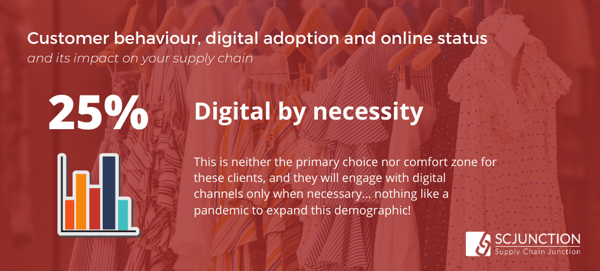
Digital by lifestyle - 23%
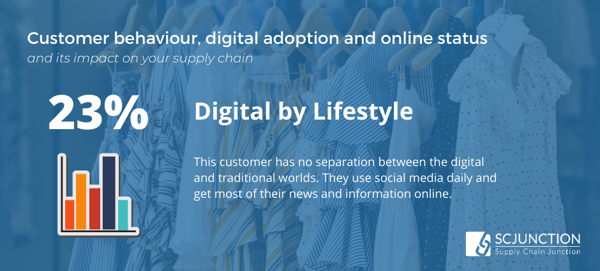
Offline society - 17%
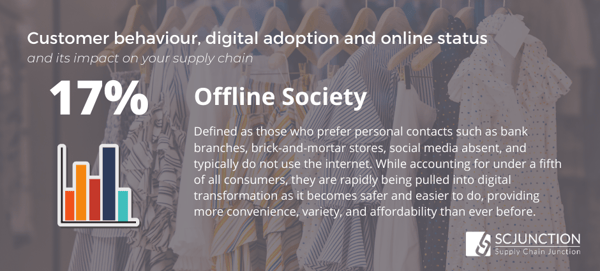
Focusing on the right customer persona will help companies prioritise their efforts, identify key attributes and characteristics to motivate each group, and then direct marketing and assets accordingly.
Best practice is to design primary service for each segment, using contact , volume, distribution and persona profiles that differentiate by digital behaviour - this will determine engagement strategies and the necessary investments in each channel.
For example: for customers who are more tech savvy, the goal might be to promote online self-service and automated tools for basic tasks such as payments and installation updates.
2. Map out customer journeys
Once companies have gained greater visibility into customer personas, they can design end-to-end service journeys across digital and live channels.
These journeys should take into account the migration of a customer across channels to ensure seamless hand-offs. It’s also critical to note that customer preferences aren’t static; they will continue to evolve, sometimes in surprising ways, based on the channels at their disposal, demographic shifts, and other factors (such as the influence of digital leaders in raising customer expectations).
To stay ahead of competitors you need to continuously anticipate and evolve by:
- Understanding the end state of the most important service journeys can help companies set goals accordingly.
- Determining which service journeys are most important in terms of the cost of the journey to the organisation, the complexity involved in improving the journey, and how important the journey is to the customer.
- Overcoming entrenched thinking and assumptions; senior managers, for example, often believe that customer care should seek to resolve issues in one session.
- Applying “test fast and learn” methodologies: industry best practices show that “customer-experience labs,” which are built like innovation centers with customers and employees jointly designing journeys, can support the quick implementation and live-testing of prototypes with customers.
- Using quantitative research (including customer surveys) and qualitative efforts (ethnographic research) can offer a comprehensive view of customer groups and segments and open executives’ eyes to customer needs.
By conducting this process for the most important journeys, companies can piece the omnichannel experience together, including additional touch-points, detailed personas, a deep understanding of pain points and delight moments, preferences, and trade-offs about channels.
A look at a typical e-commerce journey reinforces the importance of taking an omnichannel view:
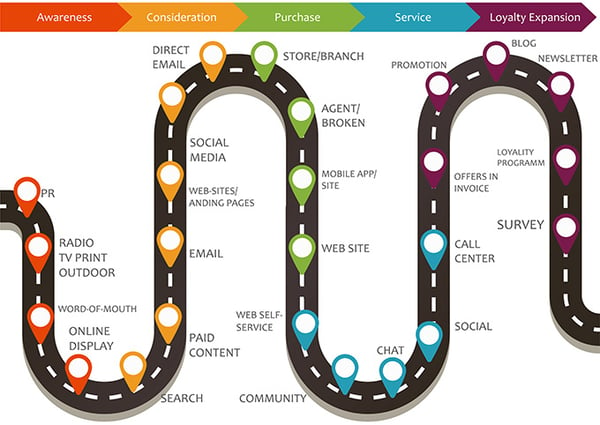
Customer first: personalise the customer journey at every step
A customer might begin online by researching products but then reach out to a live agent to get more information and inquire about inventory.
After comparing prices online and through a mobile app, he or she purchases the product online. A call to a live agent to check on the order status confirms the package’s delivery time. When the customer decides to return the product, it sets off an additional round of contact with a live agent to manage the process.
Since movement between channels has become a common occurrence, managing this movement seamlessly and providing a consistent experience are paramount to customer satisfaction.
This in-depth consideration of service journeys can enable companies to determine what capabilities they need across technology, people, and the organisation.
3. Invest in foundational enablers
To design and implement an effective omnichannel strategy, companies must embrace a customer-centric culture across all sectors. This commitment helps to guide the development of three foundational enablers:
First, agile process redesign empowers customer-care managers and agents to move more nimbly, improve transparency, and ensure front-line processes and actions are aligned with overarching business objectives. Agile methodologies create ownership for care groups, deepen their resolution skills, and establish appropriate incentives—all to accelerate progress on a customer-first, omnichannel experience. Companies should establish and test interaction models to confirm that they are providing a seamless experience across channels.
Second, the workforce must have the right service skill sets. An omnichannel transformation also requires a shift in mind-set, from one focused on execution to continuous improvement and problem solving. To support this shift, employees must also build new skills. Care agents who possess the range of skills to resolve the most complex issues are a critical component of the omnichannel model.
Third, these efforts all need to be supported by well-designed and efficient foundational capabilities, from automated measurement that enables a meaningful performance management to routing based on personal attributes, harnessing customer data using advanced analytics.
Measurement and accountability are critical to gauge the progress of the efforts above. Many companies measure KPIs, ROI and customer satisfaction among other metrics at a company level, but this doesn’t account for issues in specific parts of the customer journey and highlight specific areas of improvement.
Therefore, measurement must be sufficiently frequent to identify patterns in customer engagement and granularity to get an accurate picture of how customer care is performing at crucial interactions in each journey.
Accountability requires companies to build a cross-functional team; most companies are still organised by function, so improving a customer journey could involve operations, product development, the back office, legal, and compliance. These functions typically focus on optimising their area of the process rather than considering overall customer satisfaction: providing an excellent customer experience across multiple touch-points requires functions to coordinate their efforts more closely.
Companies should implement a cross-functional team of senior managers that is responsible for improving the customer journey. They can then convene on a biweekly basis to determine how they can collaborate to reach the business’s goals instead of focusing on their own.
4. Reinforce IT / AI architecture
The principles, service journeys, and functional enablers must be supported by an integrated software architecture that can help to deliver a seamless experience. This architecture consists of the following elements:
Omnichannel desktop Each agent’s command center integrates chat, co-browsing, and email via applications. Routing and analysis efficiently directs complex requests to skilled agents, with chat and callback offered via digital channels using javascript applications.
Omnichannel platform This platform coordinates all channels used by representatives, and routes and manages all incoming requests. An integration platform brings together a customer’s entire contact history and coordinates with the back end. Through a 360-degree customer perspective in the omnichannel desktop, representatives gain access to a self-service portal and can direct the process for customers.
Back-end interfaces A self-service portal uses back-end interfaces to handle all requests, synchronising communication. Data from these interactions is saved in data storage, where it is quickly accessible.
Advanced analytics and new technologies ...such as predicting issues before the customer explains the reason for the call, allows first movers to create positive moments for consumers. Algorithms based on natural language processing allow companies to promote behaviours to their agents to potentially influence customer satisfaction; for example, a system could coach an agent to talk slower, or to add more energy to the conversation for optimum experience.
New technologies and applications are arising each day; in the near future, they will enable companies to implement an IT backbone for an omnichannel experience that we cannot even imagine today, but must anticipate if we wish to weather the next storm.
The push to omnichannel is not confined to specific industries - it emanates from the evolution of customer preferences and behaviours as more channels and options emerge daily. While customers are becoming more tech savvy, their comfort with digital channels only serves to elevate the importance of live agent interactions. Retail companies that grasp this contradiction, who truly commit to understanding their customers' journeys, and harness the capabilities to provide seamless omnichannel service will be well-positioned to satisfy customers and survive the next inevitable change in our global economy.
Read more about omnichannel here:
Find out more about Manhattan's omnichannel offering here:
TAGS
- WMS (51)
- Warehouse Best Practice (46)
- Implementing a WMS (29)
- Managing your warehouse (19)
- Omni Channel (18)
- eCommerce (18)
- Blog (16)
- Supply Chain Best Practice (16)
- Customer Journey (9)
- Mid-Level (8)
- Warehouse optimisation (7)
- General Tips (5)
- Industry General (5)
- Information (5)
- Trends (5)
- managing your Supply Chain (5)
- saudi arabia (5)
- Press Release (4)
- smart warehouse (4)
- 3PL (3)
- News (3)
- ERP (2)
- Entry-level (2)
- ROI (2)
- Case Study (1)
- OMS (1)
- Picking (1)
- Solution-Specific (1)
- Transport Management System (1)
Take A Look At The Results Of A Successful WMS Implementation.
See how Tarsus Distribution, in collaboration with SCJ boost overall efficiency by 60%



